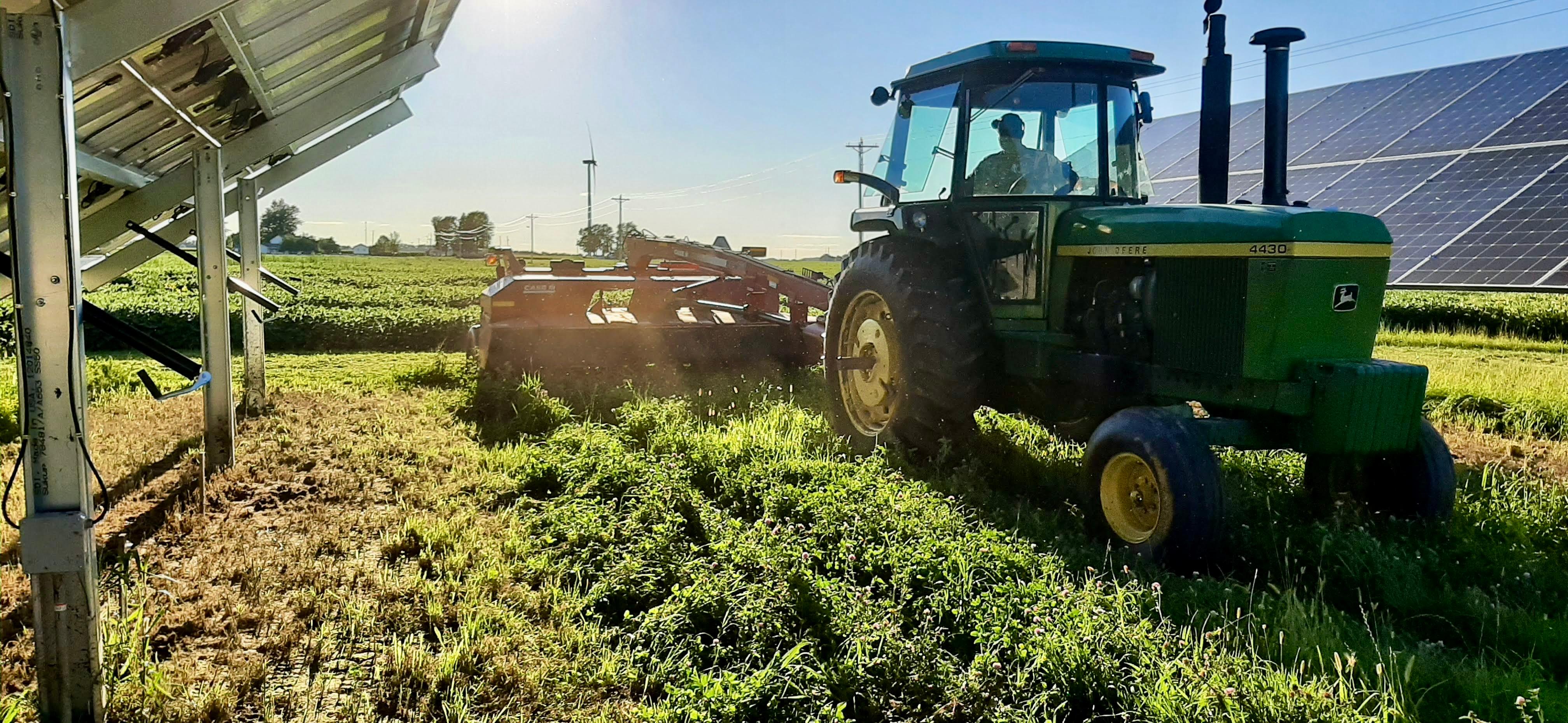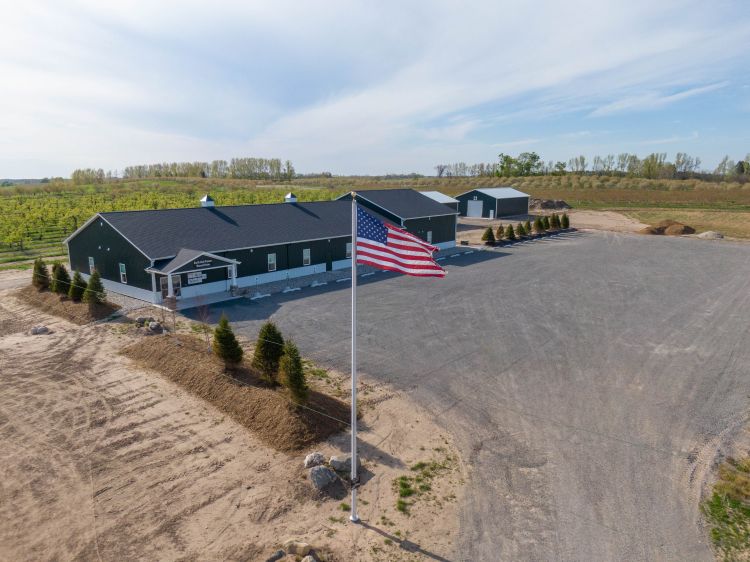MSU researchers to explore viability of agriculture, solar power generation together in Michigan
Agrivoltaics systems place solar arrays in agricultural fields alongside farming operations. MSU researchers are exploring the benefits and drawbacks of this technology that's new to Michigan.
Key Points:
-
Michigan State University researchers and MSU Extension educators are studying agrivoltaics — the integration of solar energy systems with agricultural operations.
-
Several questions have been raised with these systems, including around food safety, costs of implementation and land use. Potential benefits include additional income for farmers and more efficient water use.
-
A new project at the West Central Michigan Research and Extension Center funded by the Michigan Tree Fruit Commission will evaluate agrivoltaics in Michigan apple orchards.
EAST LANSING, Mich. — Michigan State University researchers and MSU Extension educators are evaluating the potential of agrivoltaics — which combines agricultural operations with solar energy production — in Michigan.
Agrivoltaics systems place solar panels directly in the field, either arranged several feet above agricultural activities or in rows to allow for crops or animals to be between them. The goal is to continue producing an agricultural commodity while gaining another revenue source for the farm through solar energy.

Proponents of agrivoltaics tout the dual use of agricultural land, which can allow for plant and animal agriculture operations to coexist with solar energy production and the ability to use such energy on the farm.
Benefits to soil and water are being studied around the world, possibly pointing to less water evaporation that leads to more efficient water use. Solar arrays can also promote habitat for pollinators.
However, application of solar energy projects on agricultural land is not without controversy. Opponents have introduced concerns about the removal of valuable farmland — a finite resource — from agricultural production, along with inflation of farmland prices through federal subsidies that allow energy companies to offer well over fair market value to farmers. The upfront costs of installing complex solar systems can also be a limiting factor.
Additional questions have been raised about food safety with crops grown under solar panels. When the panels are disassembled, small fragments of metal and plastic may contaminate the soil. Members of the Potato Growers of Michigan have cited this possibility as a particular concern for their crop, which is grown underground and can readily take in these objects.
Furthermore, the compatibility of agrivoltaics with Michigan’s wide range of agricultural commodities, as well as the state’s unique growing environments, is not well-studied.
George Smith, director of MSU AgBioResearch, says this information is critical to helping growers and producers make informed decisions.
“The role of MSU research and outreach is to pursue science-based recommendations for our growers and producers,” Smith said. “Our priorities are driven by the agricultural industries that rely on research, and we’re taking into account important factors such as economic viability, food safety and protecting our natural resources, among many others.
“Agrivoltaics systems are a complex issue that needs to be evaluated further, and we’re dedicated to providing the necessary information to Michigan’s agriculture stakeholders so they can make the best decisions for their industries.”
One of the common concerns with agrivoltaics is removing crops or animals from agricultural land to accommodate solar panels. This is a misconception says Charles Gould, a bioenergy educator with MSU Extension.
“We don’t have to take agricultural land out of production to introduce solar,” Gould said. “It’s not either or. It can be both. This research is new to Michigan, but it’s being done worldwide and we need to ensure we’re taking advantage of the opportunities to increase farm profitability where we can.”
Gould, who is an expert in dual-use land management, said he routinely speaks with Michigan farmers who are interested in solar technology implementation.
In July, he’s attending the AgriVoltaics World Conference in Germany, which brings together global leaders in the field. In addition to scientific information exchange, participants will tour farms that utilize solar arrays.
“We’re looking to collect as much information as possible from places that are doing this and seeing positive results, but it’s also an area in which research investment is critical,” Gould said. “There are all sorts of considerations to make. What configuration of solar panels will be conducive to productivity for certain crops? What is the ideal distance between solar panels if arranged in rows? Depending on the crop or animal involved, what height do the panels need to be above the soil surface? And ultimately, it this profitable to farmers? There are a lot of questions we need to answer, and the only way we can do that is through research.”
Investigating agrivoltaics in Michigan apple orchards
A new project supported by the Michigan Tree Fruit Commission will begin to test these systems in apple orchards, possibly including other tree fruits in the future.
Research will take place at the West Central Michigan Research and Extension Center (WCMREC) in Hart, which is supported by MSU AgBioResearch.
The research team is seeking to answer three fundamental questions:
- Can enough power be generated to provide a meaningful benefit to growers?
- How will the fruit trees respond to the agrivoltaics system?
- Is the design economically feasible for grower adoption?
The topic is of great interest to the agricultural community, as a potential revenue source and as energy and solar companies continue to purchase agricultural land. In Oceana County, where the WCMREC is located, a utility company recently purchased roughly 800 acres. This, coupled with community conversations on the issue over the past few years, prompted staff at the center to consider how solar energy and agriculture can work together.

Ashley Fleser, WCMREC farm manager who coordinates the project, indicated that while agrivoltaics offer a number of potential benefits, research in Michigan — a state with more than 300 commodities — has been limited thus far.
“We’ve learned through interactions with the community that many people are understandably skeptical of the idea,” Fleser said. “When the company purchased the land in Oceana County, which many assume will be for a future renewable energy development, this got us thinking about the possibility of integrating these two land uses — solar and agriculture. This has been done a fair amount with livestock grazing and even some vegetable production, but it’s still quite novel in tree fruit.”
Trever Meachum, chair of the Michigan Tree Fruit Commission and production manager at High Acres Fruit Farm in Van Buren County, said the research will serve as a pilot for Michigan orchards and collect much-needed information.
“This is not a completely new idea in that it’s being done all over the world — particularly in Europe, Australia and even some regions of the U.S.,” Meachum said. “But I’m not aware of any work being done in Michigan apple orchards with agrivoltaics. From research in other places, we know it works, but we don’t know how Michigan orchards will react. Are we generating enough electricity to provide a true benefit while not compromising fruit quality and productivity? That’s what we need to determine.”
Meachum indicated the priority for the tree fruit industry is to keep high-quality agricultural land productive while maximizing revenue potential for growers.
“A lot of power and solar companies are interested in purchasing or leasing good agricultural land for solar projects, and we’d like to see that land stay in production,” Meachum said. “But if there are opportunities for growers to keep farming while also diversifying revenue sources, it would be a good thing. We need some data to inform those decisions, and that’s why this research is important.”
At WCMREC, Fleser has been discussing the project with interested researchers and Extension educators, including Gould and Younsuk Dong, an assistant professor and irrigation specialist in the MSU Department of Biosystems and Agricultural Engineering.
Dong leads several research efforts looking to improve energy- and water-use efficiency across the commodity spectrum. One of these projects was funded last year by the U.S. Department of Agriculture’s Natural Resources Conservation Service and is aimed at developing a solar-powered irrigation technology that saves farmers money through more efficient use of energy and water.
“Farmers are concerned with costs, of course, and I talk to some growers who are only irrigating during certain times to avoid rising energy costs, for example,” Dong said. “Testing a system that eases the burden of rising costs and can lead to additional revenue is certainly worth exploring.”
Inspiration for the WCMREC project came, in part, from a study conducted in Belgium with pears grown in an agrivoltaics system that uses concrete trellises manufactured in Italy that are designed to accommodate the installation of solar panels. After figuring the cost to use these trellises across several acres in Michigan, it proved to be a barrier to entry for tree fruit growers.
“We pivoted to looking at whether we could develop something that deploys the panels over existing wood trellis infrastructure commonly used in Michigan for high-density tree fruits,” Fleser said. “We’re working with a local solar designer and a local fabricator to set up a small demonstration that will serve as a proof of concept.”
The team will examine the potential to offset costs of the solar infrastructure implementation through energy generation. Research will uncover just how much energy is generated, as well as how the fruit trees and environment respond to the agrivoltaics system.
“With agrivoltaics, there will be many questions moving forward,” Dong said. “This research is important because we need to find out if it’s a worthwhile investment for farmers, how it affects the crops and surrounding soil, and for which commodities it makes the most sense. Some of that may be dependent on the commodity or the size of the farm. But ultimately, asking farmers to change their operations in such a large-scale way will have to make sense economically.”
Michigan State University AgBioResearch scientists discover dynamic solutions for food systems and the environment. More than 300 MSU faculty conduct leading-edge research on a variety of topics, from health and agriculture to natural resources. Originally formed in 1888 as the Michigan Agricultural Experiment Station, MSU AgBioResearch oversees numerous on-campus research facilities, as well as 15 outlying centers throughout Michigan. To learn more, visit agbioresearch.msu.edu.



 Print
Print Email
Email




